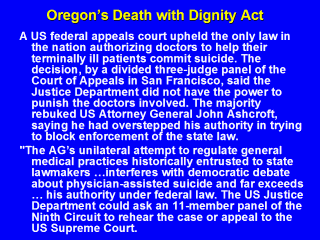| front |1 |2 |3 |4 |5 |6 |7 |8 |9 |10 |11 |12 |13 |14 |15 |16 |17 |18 |19 |20 |21 |22 |23 |24 |25 |26 |27 |28 |29 |30 |31 |32 |33 |review |

|
The assisted-suicide law in Oregon is the product of a 1994 voter initiative. It allows adults with incurable diseases who are likely to die in six months to obtain lethal drugs from their doctors. The doctors may prescribe but not administer the drugs, and are granted immunity from liability. About 30 people a year have used the law to end their lives since it became effective in 1997, about one per thousand deaths in Oregon. The court was not deciding the morality or appropriateness of assisted suicide and gave no opinion on whether the practice is inconsistent with the public interest or constitutes illegitimate medical care. This case is simply about who gets to decide. State governments bear primary responsibility for evaluating physician-assisted suicide. In our concept of federalism, and state lawmakers, not the federal government, are primary regulators of professional medical conduct. " NY Times, May 27, 2004 |